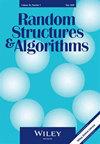Three‐wise independent random walks can be slightly unbounded
IF 0.8
3区 数学
Q4 COMPUTER SCIENCE, SOFTWARE ENGINEERING
引用次数: 0
Abstract
Recently, many streaming algorithms have utilized generalizations of the fact that the expected maximum distance of any 4‐wise independent random walk on a line over n steps is O(n)$$ O\left(\sqrt{n}\right) $$ . In this paper, we show that 4‐wise independence is required for all of these algorithms, by constructing a 3‐wise independent random walk with expected maximum distance Ω(nlgn)$$ \Omega \left(\sqrt{n}\lg n\right) $$ from the origin. We prove that this bound is tight for the first and second moment, and also extract a surprising matrix inequality from these results. Next, we consider a generalization where the steps Xi$$ {X}_i $$ are k‐wise independent random variables with bounded pth moments. We highlight the case k=4,p=2$$ k=4,p=2 $$ : here, we prove that the second moment of the furthest distance traveled is O∑Xi2$$ O\left(\sum {X}_i^2\right) $$ . This implies an asymptotically stronger statement than Kolmogorov's maximal inequality that requires only 4‐wise independent random variables, and generalizes a recent result of Błasiok.三智独立随机漫步可以稍微无界
最近,许多流算法都利用了这样一个事实,即任何4 - wise独立随机漫步在n步线上的期望最大距离为O(n)。$$ O\left(\sqrt{n}\right) $$ . 在本文中,我们通过构造一个期望最大距离Ω(nlgn)的3 - wise独立随机漫步来证明所有这些算法都需要4 - wise独立性。$$ \Omega \left(\sqrt{n}\lg n\right) $$ 从原点开始。我们证明了这个界对于一阶矩和二阶矩是紧的,并从这些结果中提取了一个令人惊讶的矩阵不等式。$$ {X}_i $$ 是具有有界PTH矩的k独立随机变量。我们强调k=4 p=2的情况$$ k=4,p=2 $$ 在这里,我们证明了最远距离的第二弯矩为O∑Xi2$$ O\left(\sum {X}_i^2\right) $$ . 这暗示了一个比只需要4个独立随机变量的Kolmogorov极大不等式更强的渐近命题,并推广了Błasiok的最新结果。
本文章由计算机程序翻译,如有差异,请以英文原文为准。
求助全文
约1分钟内获得全文
求助全文
来源期刊

Random Structures & Algorithms
数学-计算机:软件工程
CiteScore
2.50
自引率
10.00%
发文量
56
审稿时长
>12 weeks
期刊介绍:
It is the aim of this journal to meet two main objectives: to cover the latest research on discrete random structures, and to present applications of such research to problems in combinatorics and computer science. The goal is to provide a natural home for a significant body of current research, and a useful forum for ideas on future studies in randomness.
Results concerning random graphs, hypergraphs, matroids, trees, mappings, permutations, matrices, sets and orders, as well as stochastic graph processes and networks are presented with particular emphasis on the use of probabilistic methods in combinatorics as developed by Paul Erdõs. The journal focuses on probabilistic algorithms, average case analysis of deterministic algorithms, and applications of probabilistic methods to cryptography, data structures, searching and sorting. The journal also devotes space to such areas of probability theory as percolation, random walks and combinatorial aspects of probability.
 求助内容:
求助内容: 应助结果提醒方式:
应助结果提醒方式:


